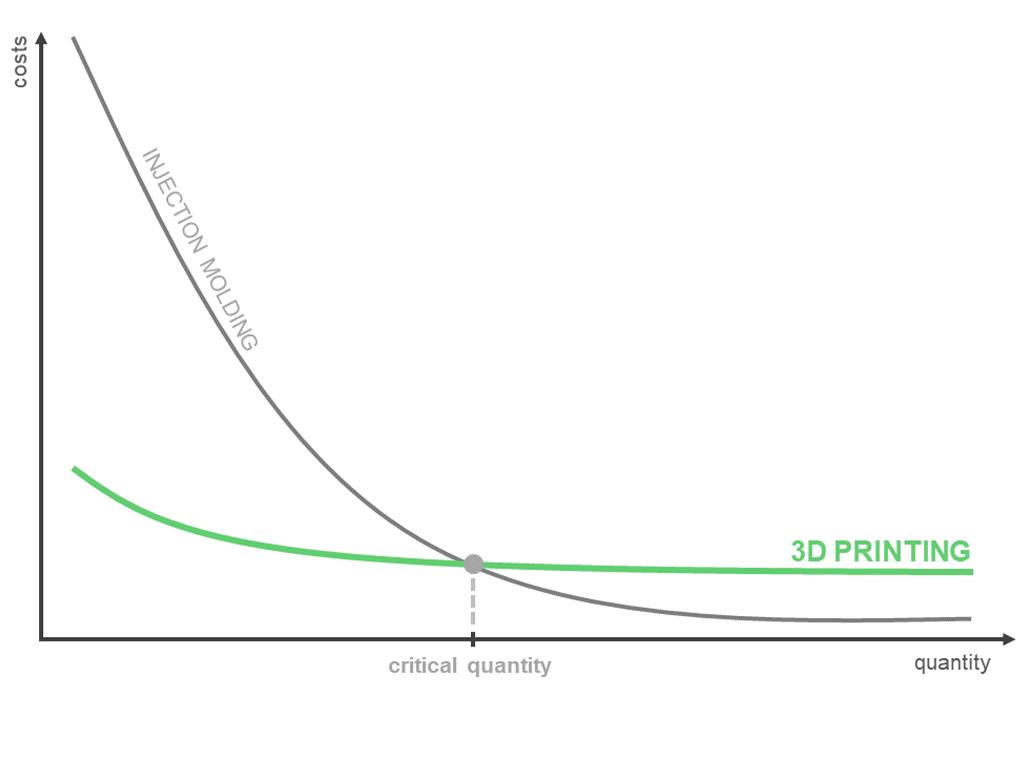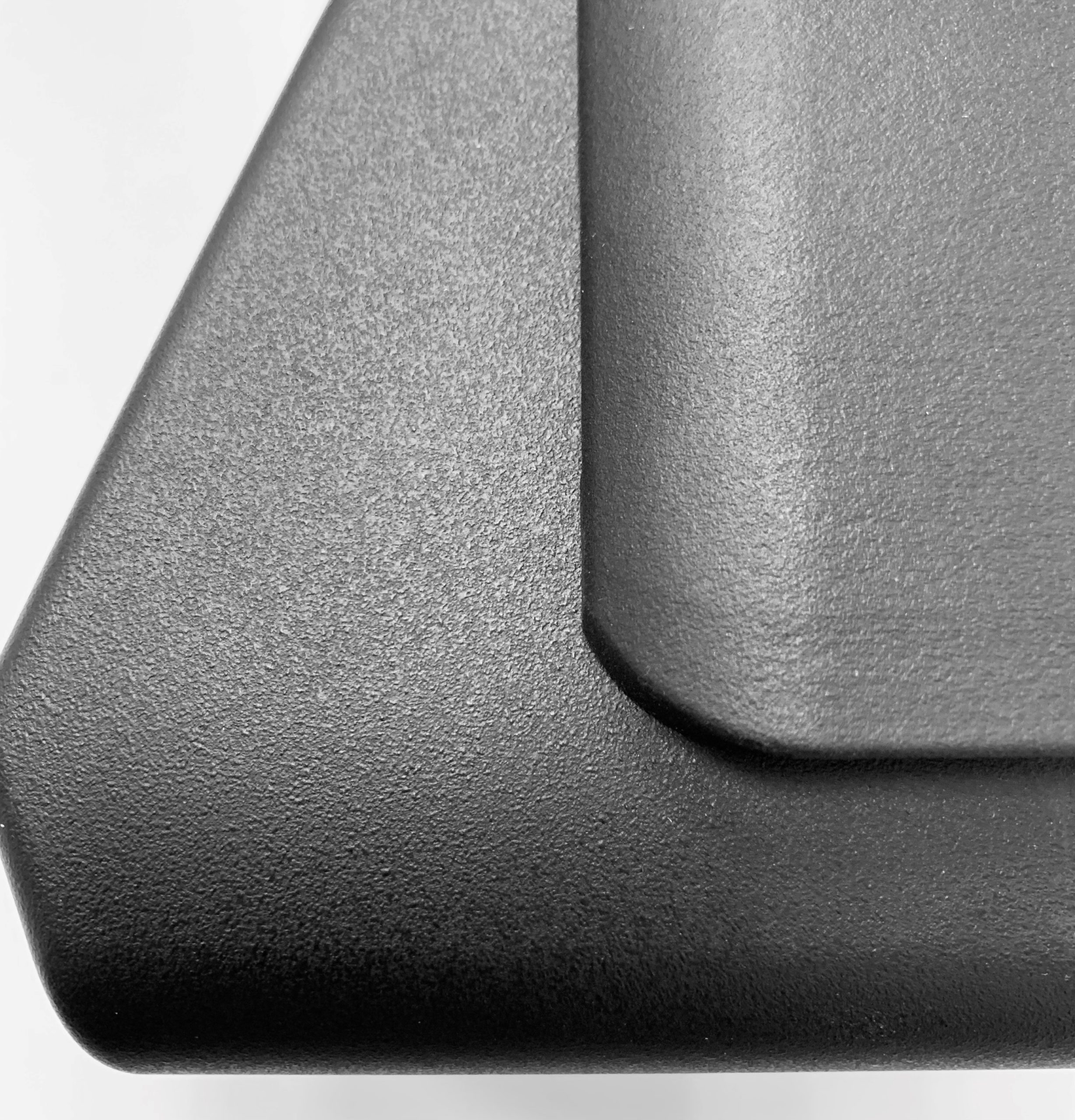Injection molding vs. 3D printing
When is which method suitable?
You need a component and are faced with the choice of whether to have it produced by injection molding or 3D printing? Both manufacturing processes can be used to produce parts and components from plastic. However, the two processes differ significantly in the way they work.
On this page we will give you an overview of this and explain the advantages and disadvantages of each technology. In doing so, we do not, though, want to prioritize one process over another. Instead, we would like to support you in finding the right method for your application.
How injection molding works
Injection molding is one of the primary forming manufacturing processes and is usually used as a mass production process. Metal, glass or elastomers can be used as materials for the process. However, thermoplastic and thermoset polymers are most commonly used. In injection molding, the components are manufactured by filling a mold with molten material, which then cools and hardens.
As the first step of the manufacturing process, the injection mold itself must be produced. This is a permanent mold, usually made of aluminum or steel, with a cavity that creates the surface structure and shape of the part to be manufactured. The tool is usually made by CNC machining from two halves. Depending on the complexity of the component, the costs for the tools can quickly amount to several 10,000€. Steel molds are also often more expensive than aluminum molds, but they also have a longer durability.
After completion of the mold, it is attached to the injection molding machine. The raw material is then in the form of granules or pellets, first heated in a screw barrel and then melted. In the next step, the material mass is pressed into the cavity of the mold at high pressure until it fills it completely. After that, the material cools down and becomes solid, taking the shape of the cavity. It is then ejected. Subsequently, post-processing can be carried out if necessary.
How 3D printing works
3D printing is an additive manufacturing process. Additive manufacturing is fundamentally different from conventional manufacturing processes. Components are not created by removing material, but are built up layer by layer. This approach allows for great flexibility and design freedom.
The basis for additive manufacturing is 3D data. These must first be prepared. In 3D printing, this is done fully automatically with a so-called "slicer". This breaks down the component into individual layers with which the 3D printer can then build up the component layer by layer and connect it to each other. After slicing, no major makeready operations are usually necessary and production can be started at the push of a button, so to speak.
The actual printing process varies in part depending on the technology. In the classic FDM process, for example, the starting material is in the form of a filament, which is then melted and applied to a plate in the desired shape. Selective laser sintering (SLS) and the HP Multi Jet Fusion (HP MJF) process, on the other hand, are powder-based processes. This means that the starting material is present as a fine plastic powder and is fused by a laser beam in the case of the SLS process and by an infrared heat source in the case of HP MJF. On our website we inform you in more detail about the functionality of our 3D printing technologies.
The two technologies compared
When choosing the most suited technology for a particular application, it is advisable to consider the following aspects:

1. Quantity
As described above, the mold must first be produced for each injection-molded component, which can be associated with high costs. In comparison, the actual production and material costs per component are only a fraction of the initial investment costs. For this reason, the component costs for this process decrease rapidly as the number of parts increases.
With 3D printing, on the other hand, the costs per component are theoretically always the same, since no special tools have to be purchased for this. In addition to the actual printing process, however, manual, upstream and downstream activities are usually necessary. The costs for this are spread over several components for higher quantities. This can also lead to a reduction in costs for higher quantities.
The search for the most favorable technology results in a critical number of items, which in our experience is usually between 500 and 1,000 parts, and it should be carefully weighed up which technology is the more favorable in the particular case of application. In general, however, 3D printing is the most economical choice, especially for small batches, and injection molding is the most economical choice, especially for high quantities.
2. Duration
The production of molds for injection molding is associated not only with financial effort, but also with time. Thus, the production of the molds can take several weeks to months. In 3D printing, on the other hand, production of the components can begin immediately as soon as 3D data is available. Once the molds for injection molding are available, however, production of a single component is many times faster than with additive manufacturing.
3. Adaptability
In terms of adaptability, 3D printing offers significant advantages. Here, changes to the 3D data can be made at any time and then implemented directly. Therefore, the process is also particularly suitable for the production of prototypes and test parts. With injection molding, a new mold must be made for each change, which in turn costs time and money.
4. Complexity / Design
3D printing also offers significantly more possibilities in terms of complexity. There are hardly any limits to the design of the components with this technology. Only a few guidelines should be followed during construction. In injection molding, on the other hand, a complex design means that mold construction also becomes significantly more complex and therefore more expensive. However, the situation is different for large and voluminous components. Since the build space of 3D printers is limited in size and printing takes a relatively long time when the build space is fully utilized, it may be worthwhile to resort to injection molding in such cases.

5. Surface quality
Due to the layer-by-layer structure in additive manufacturing, the surfaces of 3D printed components are always somewhat rough and the individual layers are usually visible. It is possible to smooth and homogenize the surfaces after printing by various finishing processes.
In the case of injection molding, on the other hand, the material is cast in a single layer, resulting in a smooth and homogeneous surface from the outset. In addition, the components can still be reworked using this process.
Conclusion
In summary, it can be said that tool-less additive manufacturing is very often the more cost-effective technology for small batches of up to 1,000 parts. Whereby it is not excluded that 3D printing is the most economical choice even for quantities of several thousand. It is therefore advisable to check this in each individual case. In addition, the process is particularly suitable for prototypes and test parts on which modifications may still have to be made, as well as for components with complex designs.
Injection molding, on the other hand, is usually the more economical method when producing high volumes. In addition, the technology can score points in the production of large and voluminous components as well as in components where a high surface quality is required.
If you would like further assistance in choosing the right technology for your application, please feel free to contact us at any time. We will be glad to help you!